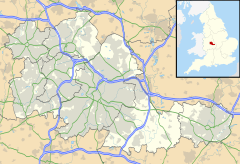Sparkbrook facts for kids
Quick facts for kids Sparkbrook |
|
|---|---|
| Population | 32,415 (2011.Ward) |
| • Density | 79.8 per ha |
| OS grid reference | SP087849 |
| Metropolitan borough | |
| Shire county | |
| Metropolitan county | |
| Region | |
| Country | England |
| Sovereign state | United Kingdom |
| Post town | BIRMINGHAM |
| Postcode district | B11 |
| Dialling code | 0121 |
| Police | West Midlands |
| Fire | West Midlands |
| Ambulance | West Midlands |
| EU Parliament | West Midlands |
| UK Parliament |
|
Sparkbrook is a busy area located in the south-east part of Birmingham, England. It's like a neighborhood within the larger city. It is also one of the special areas called 'wards' that make up the Hall Green district. This is part of how Birmingham City Council manages the city.
Contents
Where Did the Name Sparkbrook Come From?
Sparkbrook gets its name from a small stream called Spark Brook. This stream used to flow south of the city center. Later, parts of it were changed to become a canal.
Where is Sparkbrook?
Sparkbrook is surrounded by several other areas in Birmingham. To the north, you'll find Spring Vale and Bordesley. Small Heath is to the northeast, and Greet and Sparkhill are to the southeast. Balsall Heath is to the southwest, and Camp Hill and Highgate are to the northwest.
Interesting Places to Visit
Many of the churches in Sparkbrook were built a long time ago. They were constructed in the late 1800s and early 1900s.
St Agatha's Church
One of the most famous churches is St Agatha's Church. It is on the Stratford Road. This church was officially opened in 1901. It is a very important building, listed as a Grade I listed building. This means it has special historical or architectural value.
Christ Church
Christ Church was one of the oldest churches in the area. It was built in 1867. The tall spire on its tower was removed in 1918. After a bomb blast during World War II, the tower was taken down. In 1927, a special home for girls was allowed to hold public church services there. The church was damaged again by the Birmingham Tornado in 2005 and was later taken down. However, Christ Church was rebuilt in 2013. A health center on the same site was also rebuilt in 2012.
Emmanuel Church
Emmanuel Church was opened in the same year as St Agatha's Church. It was originally a smaller church connected to Christ Church. It became its own parish in 1928. Inside this church, you can find a very old, plain bell from Ullenhall.
Other Historical Buildings
- The Ladypool Road mission hall opened in 1894. It was started by the Sparkbrook Gospel Mission, which began in 1886.
- In 1849, a group called the Methodist New Connexion opened a chapel here. It was their first new chapel in 11 years.
- Lloyd House is a beautiful Georgian building. It is located on Sampson Road. Sampson Lloyd, who started Lloyds Bank, built it between 1742 and 1752. Today, the Bromford Corinthia Housing Association uses the building as offices.
- In 1780, Sparkbrook was home to Joseph Priestley. He was a very important scientist who helped create modern chemistry. In 1791, his large house was partly destroyed during what are known as the Priestley riots. His house stood on what is now Priestley Road.
- Sparkbrook is also home to the famous Farm Park. It is just off the Stratford Road, near Grantham Road.
Population and Culture
The 2001 Census counted 31,485 people living in Sparkbrook. Sparkbrook has a very diverse population. About 78% of its residents are from minority ethnic groups. Many people live in terraced houses in the area. It is especially known for having a large Somali community. Sparkbrook is also home to Birmingham's "Balti Triangle". Many residents own their own balti restaurants, which serve a special type of curry.
Images for kids
-
The home of Sampson Lloyd II – founder of Lloyds Bank – in Farm Park



